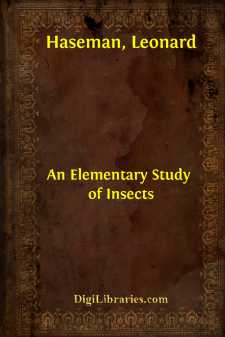Categories
- Antiques & Collectibles 13
- Architecture 36
- Art 48
- Bibles 22
- Biography & Autobiography 813
- Body, Mind & Spirit 142
- Business & Economics 28
- Children's Books 14
- Children's Fiction 11
- Computers 4
- Cooking 94
- Crafts & Hobbies 4
- Drama 346
- Education 46
- Family & Relationships 57
- Fiction 11829
- Games 19
- Gardening 17
- Health & Fitness 34
- History 1377
- House & Home 1
- Humor 147
- Juvenile Fiction 1873
- Juvenile Nonfiction 202
- Language Arts & Disciplines 88
- Law 16
- Literary Collections 686
- Literary Criticism 179
- Mathematics 13
- Medical 41
- Music 40
- Nature 179
- Non-Classifiable 1768
- Performing Arts 7
- Periodicals 1453
- Philosophy 64
- Photography 2
- Poetry 896
- Political Science 203
- Psychology 42
- Reference 154
- Religion 513
- Science 126
- Self-Help 84
- Social Science 81
- Sports & Recreation 34
- Study Aids 3
- Technology & Engineering 59
- Transportation 23
- Travel 463
- True Crime 29
An Elementary Study of Insects
by: Leonard Haseman
Categories:
Description:
Excerpt
INTRODUCTION
In the preparation of a book of this nature, to be used in the grade schools, we realize that the one fundamental thing to keep in mind is the economic importance of the insect, be it good or bad. The child wants to know what is good and what is bad and how he can make use of the good and how he can get rid of the bad. And yet there is something more associated with the life, work and development of each tiny insect. There is a story—a story of growth, not unlike that of the developing child, a story of courage, strife and ultimate success or failure, which is as interesting and of greater value to the child than many of the stories of adventure and of historical facts. Snatches of these stories will appear in the following chapters along with the studies on insects and their economic importance.
In the development of our grade school system, especially in the rural districts, there is a growing demand for some practical work along with the regular cultural studies. To the child in the rural schools, practical knowledge naturally tends toward agriculture. Many of these boys and girls do not have a chance to pursue studies beyond the grades and it therefore becomes necessary to introduce some elementary agriculture into the grades to supply the natural craving of this vast assemblage of children in the rural schools of our land.
In the search for a study which will give unlimited scope for independent thought and observation and which will lead the child to understand better the forces of nature that affect agriculture, nothing is so readily available and attractive to the child as nature study, an elementary study of the natural sciences. In fact agriculture is primarily a course in nature study where we study how plants and animals struggle for existence.
There is a period in the life of every child when he is especially susceptible to the "call of the fields;" when he roams through woods or by shady brooks gathering flowers, fishing for mud-cats and cleaning out bumble-bees' nests. It is often compared with the life of the savage and is merely the outward expression of an inward craving for a closer relation with nature and her creatures. If one can reach a child while at that age he has a ready listener and an apt pupil. That is the time to guide and instruct the child along the line of nature study.
The most important questions confronting the average teacher in the grade schools are: "What material shall I use and how shall I proceed to direct the child along this line?" First of all use that material which is most readily available, which is most familiar to the child and which will attract and hold his attention. There is nothing so readily available and so generally interesting to both boys and girls as are the thousands of fluttering, buzzing, hopping and creeping forms of insects. They are present everywhere, in all seasons and are known to every child of the city or farm. They are easily observed in the field and can be kept in confinement for study. Many of them are of the greatest importance to man; a study of them becomes of special value.
In pursuing a study of nature and her creatures one should go into the woods and fields as much as possible and study them where they are found. In this way one can determine how they live together, what they feed on and the various other questions which the inquisitive mind of a healthy child will ask. When field work is not possible, gather the insects and keep them alive in jars where they can be fed and observed. Some forms cannot be kept in confinement and in such cases samples should be killed and pinned, thereby forming a collection for study.
Most of the forms which are included in the following chapters can be kept in confinement in glass jars or studies out doors. The studies have been made so general that in case the particular form mentioned is not available any closely related form can be used. Each child should make a small collection of living and pinned insects for study and should be encouraged to observe insects and their work in the field. The collections and many of the observations could be made to good advantage during the summer vacation when the insects are most abundant and active....


